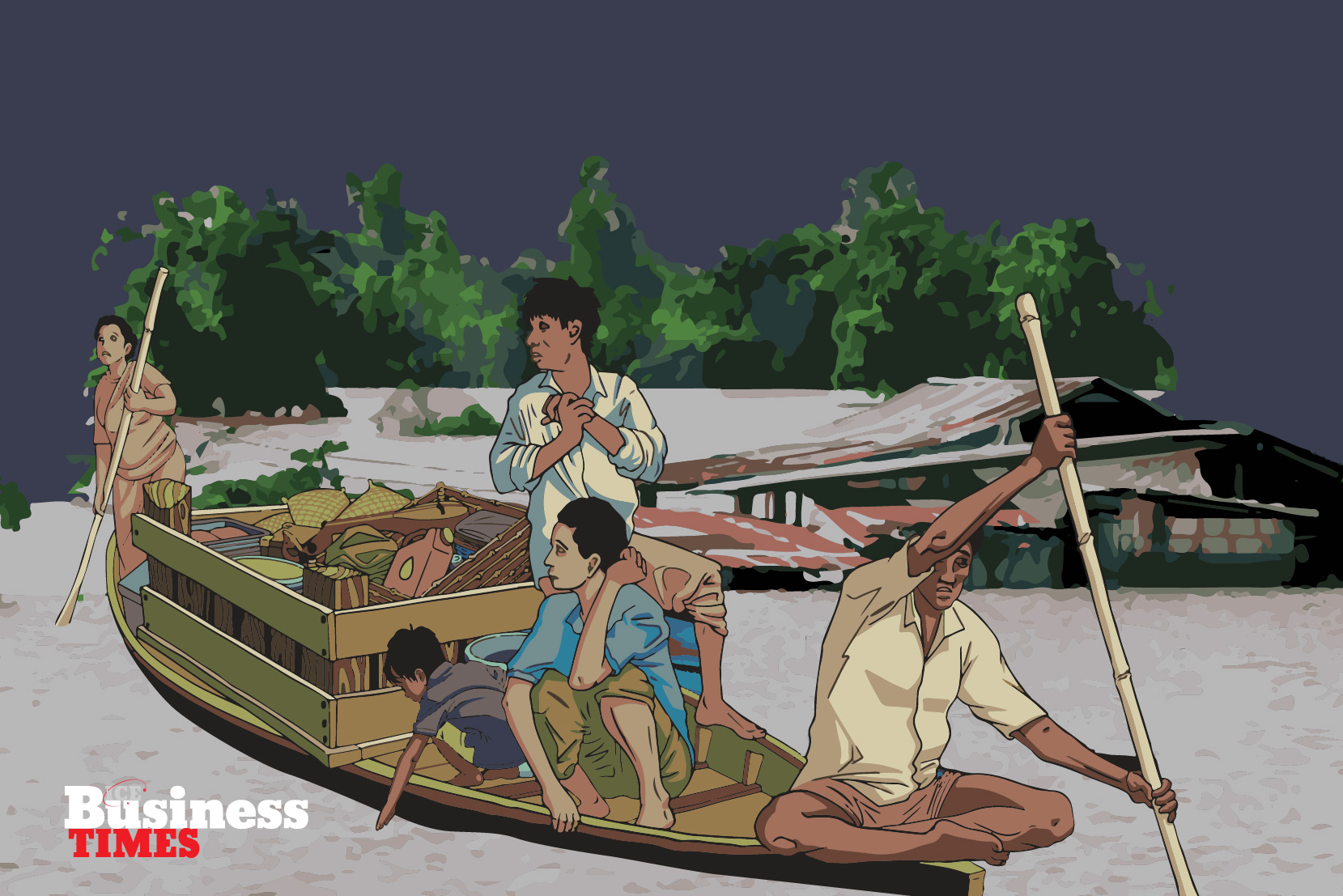Perspectives, insights, and stories from notable personalities at a Bengal Institute seminar celebrating the centenary of the eminent architect, Muzharul Islam.
Architect Muzharul Islam (1923 – 2012) is revered as the pioneer of modern architecture in Bangladesh. His contributions go beyond just the field of architecture; his understanding of the societal and cultural impact of British colonisation on Bangladesh, leading to dislocation and deviation, shaped his perspective on the role of architecture in reconnecting with the country’s traditions. His dedication to using architecture as a means of societal progress reflects a broader vision where the profession goes beyond aesthetics and becomes a tool for upholding a civilised society.
On 9 December 2023, the Bengal Institute for Architecture, Landscapes and Settlements held a Special Seminar commemorating and discussing the life and work of Muzharul Islam. The seminar included three sessions, each dedicated to particular strands in the life and work of Muzharul Islam.
THE ARCHITECTURAL REALM
Architects Ehsan Khan, Khondaker Hasibul Kabir, Luva Nahid Chowdhury and Professor Syed Manzoorul Islam spoke during the first session, ‘The Architectural Realm: The Evolution of an Architecture’.
Ehsan Khan’s exploration of Muzharul Islam’s architectural legacy reveals three overarching ideas that span the architect’s extensive body of work from 1950 to 2000. First, Muzharul Islam conceptualised architecture liberated from the ground, envisioning ground floors as spaces for people to engage, exchange ideas, and foster unity. The iconic Dhaka University Library, with its open ground floor, stands as a symbol of this idea, serving as a platform for intellectual exchange and contributing to mental and psychological development. Next, in the 1960s, Muzharul Islam introduced an innovative approach to space utilisation, featuring smaller ground floors compared to the stories above, projecting outward. This design language, exemplified in structures like Nipa Bhaban, seamlessly integrated structural, construction, technological, and craftsmanship elements. Lastly, Muzharul Islam aimed to connect the past to the present by incorporating visible masonry work and developing Bangladesh’s masonry language. His buildings sought harmony with the landscape, climate, society, and culture, enriched by nature’s elements and offering climate-appropriate adaptations. Projects like Chittagong University, nestled in a hilly region, exemplify this connection to the ground, while Jahangirnagar University demonstrates his success in generating a pattern suitable for a city with a focus on climate, psychology, and artistic expression. The monumental scale of these designs reflects not only the strength of the institutions they represent but also Muzharul Islam’s vision of architecture transcending traditional boundaries, contributing to nation-building, and providing a roadmap and framework for future architects.
Professor Syed Manzoorul Islam recognised Muzharul Islam as a truly interdisciplinary figure, attributing significant importance to culture as the cornerstone of Muzharul Islam’s architectural philosophy.
Architect Khondaker Hasibul Kabir emphasised Muzharul Islam’s perspective on architecture as a practice with the potential to positively impact the lives of all members of society.
Architect Luva Nahid Chowdhury provided a distinctive perspective on Muzharul Islam’s connection with modern architecture. While he is often recognised as the pioneer of modern architecture in Bangladesh, she argued that Muzharul Islam intended for Bangladesh to develop its own interpretation of modern architecture. Rather than being mere consumers or imitators, he urged the creation of a distinct language of modern architecture.
Professor Syed Manzoorul Islam recognised Muzharul Islam as a truly interdisciplinary figure, attributing significant importance to culture as the cornerstone of Muzharul Islam’s architectural philosophy. Muzharul Islam, in his view, went beyond viewing architecture merely as an aesthetic pursuit or an application of technology. Instead, he believed in guiding architecture with a sense of common good, aiming to impact the lives of the general populace.
THE POLITICAL REALM
In this session, ‘The Political Realm: Rethinking Muzharul Islam’s Architecture and Politics’, the speakers were Architect Kazi Khaleed Ashraf, Mofidul Hoque, Architect Nurur Rahman Khan, and Professor Niaz Zaman. Kazi Khaleed Ashraf briefly spoke of Muzharul Islam’s political inspiration. Through his research on Muzharul Islam, Ashraf found that two books had a significant impact on Islam’s life: the first being the work of Swiss-French architect Le Corbusier, titled Towards an Architecture, and the second being India in Transition by Indian political theorist and socialist M.N. Roy. Corbusier’s book made a substantial contribution to the establishment of modern architecture, while Roy’s work is a living document of hope for building a new society after the end of British colonisation in India. Muzharul Islam, according to Ashraf’s findings, was a convergence of these two ideas – left politics and architecture. After Bangladesh gained independence, Islam saw an opportunity to bring progressive change to the country through physical planning and social housing. Presenting these findings to set the stage for further discussion during the session, Ashraf then invited the other panellists to share their thoughts.
Mofidul Hoque’s initial association with Muzharul Islam was through Chhayanaut, a cultural organisation in which Muzharul Islam played a significant role. Chhayanaut focused on preserving and practising the cultural heritage of Bangladesh, contributing to the revival of Bangladeshi nationality as a distinct identity. Muzharul Islam’s architectural works aligned with this idea, emphasising that architecture should reflect the essence of being Bangladeshi. The impact of Muzharul Islam’s works is vividly illustrated through Mofidul Hoque’s memories of his student life at Dhaka University. Kola Bhaban, a newly constructed building at the time, piqued Hoque’s interest, but it was the library designed by Muzharul Islam that drew him in. The library’s structure, the staircase, and the overall environment resonated deeply with people’s sentiments, creating a sense of belonging. Hoque emphasised that these spaces played a crucial role in fostering a sense of Bengali identity, moulding an entire generation. Through his architectural endeavours, Muzharul Islam became a vital part of the movement, leaving a lasting impact on the cultural and national consciousness of the Bangladeshi people.
Professor Niaz Zaman resonated with Mofidul Hoque, reiterating Muzharul Islam as being proudly nationalistic, and adamant in loving his country. She kept her story short but added that Muzharul Islam was the one who inspired her to look at buildings and find their connection to history, politics, and architecture.
Muzharul Islam, according to Ashraf’s findings, was a convergence of these two ideas – left politics and architecture. After Bangladesh gained independence, Islam saw an opportunity to bring progressive change to the country through physical planning and social housing.
Architect Nurur Rahman Khan delved into the connection between architecture and politics by first defining the essence of being political – a state of consciousness. In his view, those who remain apolitical lack this consciousness. Khan asserts that the purpose of architecture is to identify what holds significance. For Muzharul Islam, aligning with the left was not a mere trend; rather, it was deeply rooted in his belief system that it was the right direction for a country like Bangladesh.
The Bengal Famine of 1943 acted as an inspiration for nationalism, influencing Muzharul Islam’s post-colonial architecture, free from any colonial remnants. His rejection of British influence was absolute, driven by a sense of obligation to contribute to the nation’s growth. Nurur Rahman Khan highlights the significance of Muzharul Islam’s second building, the Dhaka University Library. Muzharul Islam considered a library a place of great importance, emphasising the value of knowledge. He collaborated with artists who shared his left-wing political beliefs, incorporating two artworks – one depicting a composition of books and the other a fisherman’s village. The purpose was to remind readers of their country and existence in various walks of life, symbolised by boatmen and a fisherman’s village on the first floor before entering the main reading hall. The placement of these artworks was a powerful expression of Muzharul Islam’s associations and intentions, representing a form of resistance that is often lost in contemporary architecture.
Muzharul Islam, according to Khan, stands as a symbol of resistance in the field of architecture, reminding architects today of the importance of embodying resistance in their work.
THE CULTURAL REALM
Architects Saif Ul Haque, Uttam Kumar Saha, Jalal Ahmed and Professor Muntasir Mamoon spoke in the final session, ‘The Cultural Realm: Chetana as a Movement’.
Architect Saif Ul Haque shed light on the Chetana movement initiated by Muzharul Islam in 1983. The Chetana movement began as an educational endeavour. He conducted design classes for two months, teaching the intricacies of design, site, and rhythm. Under Muzharul Islam’s guidance, Chetana organised events and established communication with overseas counterparts. The movement aimed at nurturing architectural knowledge, encouraging self-discovery, understanding one’s country, culture, and tradition, and engaging with activities both domestically and internationally. The culmination of Chetana in 1997 coincided with the publication of the book Chetana, signifying the conclusion of this influential movement initiated by Muzharul Islam.
Architect Jalal Uddin Ahmed underscored the significance of Chetana in bringing individuals from diverse disciplines together to offer context and bridge a disconnect between Bengal and its architecture. He mentioned that Chetana played a crucial role in teaching him that in order to be an architect for the people of Bangladesh, architecture must be integrated with elements that colonisation had detached from it. This integration includes considerations of origins, history, society, culture, politics, environment, economics, tradition, and various other aspects. Chetana, therefore, served as a platform for architects to understand the holistic and interconnected nature of their field, emphasising the need to incorporate a wide range of factors in architectural practice in order to truly serve the needs and context of the people in Bangladesh.
Professor Muntasir Mamoon delved into Muzharul Islam’s novel ideology of socialism rooted in democracy – one which would be characterised by a sense of universality.
In a wholesome conclusion to the seminar, architect Uttam Kumar Saha, feeling a sense of inadequacy in finding sufficient words to thoroughly express his sentiments about Muzharul Islam, chose to convey his emotions through a verse from a Rabindra Sangeet. This poetic expression encapsulated his deep connection and reverence for Muzharul Islam. In concluding his final thoughts, Saha emphasised Muzharul Islam’s role as an educator, highlighting the architect’s enduring enthusiasm for teaching students.
In addition to offering insightful reflections on Muzharul Islam’s remarkable and varied contributions to the architectural culture of the country, the seminar, attended by individuals from diverse fields, was enriched by the sharing of personal anecdotes and reflections by the participants.

















